Reservoir Sediment Management and Downstream River Impacts for Sustainable Water Resources—Case Study of Shihmen Reservoir
Abstract
:1. Introduction
2. Materials
2.1. Study Site and Hydrological Conditions
2.2. Desilting Plans in Shihmen Reservoir
2.2.1. Modification of Power Plant Penstock
2.2.2. Amuping and Dawanping Desilting Tunnels
3. Methods
3.1. Assessment Indexes of Sediment Desilting Techniques
3.2. Brune Curve Approach for Trapping Efficiency
3.3. Hydromorphological Model
4. Results and Discussions
4.1. Long-Term Projection of Storage Capacity under Sediment Management
4.2. Long-Term Projection of Water Demand under Sediment Management
4.3. Sediment Concentration Variations in the Downstream River during the Flood Event
4.4. Long-Term Downstream Impact under Desilting Operation
5. Conclusions
Author Contributions
Funding
Institutional Review Board Statement
Informed Consent Statement
Data Availability Statement
Acknowledgments
Conflicts of Interest
References
- Ait Kadi, M. Water for development and development for water: Realizing the Sustainable Development Goals (SDGs) Vision. Aquat. Procedia 2016, 6, 106–110. [Google Scholar] [CrossRef]
- United Nations. Sustainable Development Goal 6: Synthesis Report 2018 on Water and Sanitation; United Nations: New York, NY, USA, 2018. [Google Scholar]
- Shiklomanov, I.A. Chapter 2 World Fresh Water Resources. In Water in Crisis: A Guide to the World’s Fresh Water Resources; Peter, H.G., Ed.; Oxford University Press: New York, NY, USA, 1993. [Google Scholar]
- Morris, G.L.; Fan, J.H. Reservoir Sedimentation Handbook: Design and Management of Dams, Reservoirs, and Watersheds for Sustainable Use; Electronic Version, Version 1.01; McGraw-Hill Book Co: New York, NY, USA, 2009. [Google Scholar]
- Chen, R.S.; Tsai, C.M. Development of an evaluation system for sustaining reservoir functions—A Case Study of Shiwen Reservoir in Taiwan. Sustainability 2017, 9, 1387. [Google Scholar] [CrossRef] [Green Version]
- Peters, R.; Berlekamp, J.; Lucía, A.; Stefani, V.; Tockner, K.; Christiane Zarfl, C. Integrated impact assessment for sustainable hydropower planning in the Vjosa catchment (Greece, Albania). Sustainability 2021, 13, 1514. [Google Scholar] [CrossRef]
- Daus, M.; Koberger, K.; Koca, K.; Beckers, F.; Fernández, J.E.; Weisbrod, B.; Dietrich, D.; Gerbersdorf, S.U.; Glaser, R.; Haun, S.; et al. Interdisciplinary reservoir management—A Tool for sustainable water resources management. Sustainability 2021, 13, 4498. [Google Scholar] [CrossRef]
- Mahmood, K. Reservoir Sedimentation: Impact, Extent, Mitigation; World Bank Technical Report No. 71; World Bank: Washington, DC, USA, 1987. [Google Scholar]
- ICOLD. Sedimentation and Sustainable Use of Reservoirs and River Systems; Sedimentation Committee 2009; Draft ICOLD Bulletin; ICOLD: Paris, France, 2009. [Google Scholar]
- Wisser, D.; Frolking, S.; Hagen, S.; Bierkens, M.F.P. Beyond peak reservoir storage? A global estimate of declining water storage capacity in large reservoirs. Water Resour. Res. 2013, 49, 5732–5739. [Google Scholar] [CrossRef] [Green Version]
- Jiang, N.; Fu, L. Problems of reservoir sedimentation in China. Chin. Geogr. Sci. 1998, 8, 117–125. [Google Scholar] [CrossRef]
- Patra, B.; Giri, S.; Narayan, P. Reservoir sedimentation in Indian dam: Trend and challenges. In Proceedings of the International Dam Safety Conference, Bhubaneswar, India, 13–14 February 2019. [Google Scholar]
- Water Resources Planning Institute. Reservoir Desiltation Technology and Management; Water Resources Agency: Taipei, Taiwan, 2020. [Google Scholar]
- Annandale, G.W.; Morris, G.L.; Karki, P. Extending the Life of Reservoirs: Sustainable Sediment Management for Dams and Run-of-River Hydropower; World Bank Publications: Washington, DC, USA, 2016. [Google Scholar]
- Ehrbar, D.; Schmocker, L.; Doering, M.; Cortesi, M.; Bourban, G.; Boes, R.M.; Vetsch, D.F. Continuous seasonal and large-scale periglacial reservoir sedimentation. Sustainability 2018, 10, 3265. [Google Scholar] [CrossRef] [Green Version]
- Kondolf, G.M. Sediment management at the river-basin scale: Challenges and opportunities. In Proceedings of the 3rd International Workshop on Sediment Bypass Tunnels, Taipei, Taiwan, 9–12 April 2019. [Google Scholar]
- Wang, H.W.; Tsai, B.S.; Hwang, C.; Chen, G.W.; Kuo, W.C. Efficiency of the drawdown flushing and partition desilting of a reservoir in Taiwan. Water 2020, 12, 2166. [Google Scholar] [CrossRef]
- Gurmu, Z.A.; Ritzema, H.; de Fraiture, C.; Ayana, M. Stakeholder roles and perspectives on sedimentation management in small-scale irrigation schemes in Ethiopia. Sustainability 2019, 11, 6121. [Google Scholar] [CrossRef] [Green Version]
- Du, M.; Mu, X.; Zhao, G.; Gao, P.; Sun, W. Changes in runoff and sediment load and potential causes in the Malian river basin on the Loess Plateau. Sustainability 2021, 13, 443. [Google Scholar] [CrossRef]
- Bhatti, M.T.; Ashraf, M.; Anwar, A.A. Soil erosion and sediment load management strategies for sustainable irrigation in arid regions. Sustainability 2021, 13, 3547. [Google Scholar] [CrossRef]
- Lai, J.S.; Shen, H.W. Flushing sediment through reservoirs. J. Hydraul. Res. 1996, 34, 237–255. [Google Scholar] [CrossRef]
- Shen, H.W.; Lai, J.S. Sustain reservoir useful life by flushing sediment. Intl. J. Sediment. Res. 1996, 11, 10–17. [Google Scholar]
- Kondolf, M.; Gao, Y.; Annandale, G.W.; Morris, G.L.; Jiang, E.; Zhang, J.; Cao, Y.; Carling, P.; Fu, K.; Guo, Q.; et al. Sustainable sediment management in reservoirs and regulated rivers: Experiences from five continents. Earths Future 2014, 2, 256–280. [Google Scholar] [CrossRef]
- Atkinson, E. The Feasibility of Flushing Sediment from Reservoirs; Report OD 137; HR Wallingford: Wallingford, UK, 1996. [Google Scholar]
- Ren, S.; Zhang, B.; Wang, W.J.; Yuan, Y.; Guo, C. Sedimentation and its response to management strategies of the Three Gorges Reservoir, Yangtze River, China. Catena 2021, 199, 105096. [Google Scholar] [CrossRef]
- Basson, G.R.; Rooseboom, A. Dealing with Reservoir Sedimentation. South Africa; Report No. TT 91/97; Water Research Commission: Pretoria, South Africa, 1997. [Google Scholar]
- Sumi, T.; Kobayshi, K.; Yamaguchi, K.; Takata, Y. Study on the applicability of the asset management for reservoir sediment management. In Proceedings of the International Congress on Large Dams, Brasilia, Brazil, 25–29 May 2009. [Google Scholar]
- Sumi, T.; Lee, F.Z.; Lai, J.S.; Tan, Y.C.; Huang, C.C. Flushing replenished sediment on floodplain downstream of a reservoir. In Proceedings of the International Symposium on Dams for a Changing World, Kyoto, Japan, 5 June 2012. [Google Scholar]
- Palmieri, A.; Shah, F.; Annandale, G.; Dinar, A. Reservoir conservation—Economic and Engineering Evaluation of Alternative Strategies for Managing Sedimentation in Storage Reservoirs: The RESCON Approach; World Bank: Washington, DC, USA, 2003; Volume 1. [Google Scholar]
- Sumi, T.; Kantoush, S.A. Innovative strategies for managing reservoir sedimentation in Japan. Hydrolink 2018, 4, 100–104. [Google Scholar]
- Sumi, T. New sediment bypass schemes in Sakuma and Yahagi Dams in Japan. In Proceedings of the 3rd International Workshop on Sediment Bypass Tunnels, Taipei, Taiwan, 10–13 April 2019. [Google Scholar]
- Boes, R.M.; Müller-Hagmann, M.; Albayrak, I. Design, operation and morphological effects of bypass tunnels as a sediment routing technique. In Proceedings of the 3rd International Workshop on Sediment Bypass Tunnels, Taipei, Taiwan, 9–12 April 2019. [Google Scholar]
- Sakamoto, T.; Sumi, T.; Hakoishi, N. New paradigms on sediment management for reservoir and river sustainability in Japan. Hydropower Dams 2018, 25(2). Available online: https://www.hydropower-dams.com/articles/new-paradigms-on-sediment-management-for-reservoir-and-river-basin-sustainability-in-japan/ (accessed on 2 February 2022).
- Tsai, F.; Lai, J.-S.; Chen, W.W.; Lin, T.-H. Analysis of topographic and vegetative factors with data mining for landslide verification. Ecol. Eng. 2013, 61, 669–677. [Google Scholar] [CrossRef]
- Lin, C.P.; Chung, C.C.; Wu, I.L.; Wu, P.L.; Lin, C.H.; Wu, C.H. Extensive monitoring system of sediment transport for reservoir sediment management. In Natural Resources and Control Processes, 1st ed.; Springer: Basel, Switzerland, 2016; Volume 17, pp. 449–492. [Google Scholar]
- Chiu, Y.J.; Lee, H.Y.; Wang, T.L.; Yu, J.; Lin, Y.T.; Yuan, Y. Modeling sediment yields and stream stability due to sediment-related disaster in Shihmen Reservoir watershed in Taiwan. Water 2019, 11, 332. [Google Scholar] [CrossRef] [Green Version]
- Lin, B.S.; Chen, C.K.; Thomas, K.; Hsu, C.K.; Ho, H.C. Improvement of the k-factor of USLE and soil erosion estimation in Shihmen reservoir watershed. Sustainability 2019, 11, 355. [Google Scholar] [CrossRef] [Green Version]
- Northern Region Water Resources Office, WRA, MOEA. 109 Annual Topographic Survey of Reservoirs and Dams under the Administration of the Bureau Topographic Survey Results Report for the Water Storage Area of Shihmen Reservoir; Northern Region Water Resources Office: Taoyuan, Taiwan, 2020. (In Chinese) [Google Scholar]
- Wang, H.W.; Kondolf, G.M.; Tullos, D.; Kuo, W.C. Sediment management in Taiwan’s reservoirs and barriers to implementation. Water 2018, 10, 1034. [Google Scholar] [CrossRef] [Green Version]
- Huang, C.C.; Lai, Y.G.; Lai, J.S.; Tan, Y.C. Field and numerical modeling study of turbidity current in Shimen Reservoir during typhoon events. J. Hydraul. Eng. 2019, 145, 05019003. [Google Scholar] [CrossRef]
- Chen, C.Y.; Chen, L.K.; Yu, F.C.; Lin, Y.C.; Lee, C.L.; Wang, Y.T. Landslides affecting sedimentary characteristics of reservoir basin. Environ. Earth Sci. 2010, 59, 1693–1702. [Google Scholar] [CrossRef] [Green Version]
- Water Resources Planning Institute. Hydraulic Model Studies for Sediment Sluicing and Flood Diversion Engineering of Shihman Reservoir; Technical report; Water Resources Planning Institute: Taichung, Taiwan, 2012. (In Chinese) [Google Scholar]
- Water Resources Planning Institute. Feasibility Study of Dawanping Desilting Tunnel Project in Shihmen Reservoir; Summary Report; Water Resources Planning Institute: Taichung, Taiwan, 2011. (In Chinese) [Google Scholar]
- Northern Region Water Resources Office, WRA, MOEA. Desilting Tunnel of Shimen Reservoir (First Stage); The Basic Design Report of Amouping Tunnel; Northern Region Water Resources Office: Taoyuan, Taiwan, 2015. (In Chinese) [Google Scholar]
- Northern Region Water Resources Office, WRA, MOEA. Shihmen Reservoir Existing Facility Desilting Enhance Project—Phase 1 Power Plant Desilting Project Completion Report; Northern Region Water Resources Office: Taoyuan, Taiwan, 2013. (In Chinese) [Google Scholar]
- Water Resources Agency, MOEA. Amuping Desilting Project of Shihmen Reservoir, Technical report of approved version; Water Resources Agency: Taipei, Taiwan, 2014. (In Chinese) [Google Scholar]
- Lai, J.S.; Lee, F.Z.; Wu, C.H.; Tan, Y.C.; Sumi, T. Sediment bypass tunnels of the Shihmen Reservoir in Taiwan. In Proceedings of the 1st International Workshop on Sediment Bypass Tunnels, Zurich, Switzerland, 27–29 April 2015. [Google Scholar]
- Northern Region Water Resources Office. Impacts and Improvement Strategies on the Downstream River Sediment Concentration and Bed Evolution by the Operation of Flood Control and Sediment Desiltation of the Shihmen Reservoir; Technical Report; National Taiwan University: Taipei, Taiwan, 2015. (In Chinese) [Google Scholar]
- Sumi, T.; Kantoush, S.A. Comprehensive Sediment Management Strategies in Japan: Sediment Bypass Tunnels. In Proceedings of the 34th IAHR World Congress, Brisbane, Australia, 26 June–1 July 2011; pp. 1803–1810. [Google Scholar]
- Brune, G.M. Trap efficiency of reservoirs. Trans. Am. Geophys. Union 1953, 34, 407–418. [Google Scholar] [CrossRef]
- Lewis, S.E.; Bainbridge, Z.T.; Kuhnert, P.M.; Sherman, B.S.; Henderson, B.; Dougall, C.; Cooper, M.; Brodie, J.E. Calculating sediment trapping efficiencies for reservoirs in tropical settings: A case study from the burdekin falls dam, NE Australia. Water Resour. Res. 2013, 49, 1017–1029. [Google Scholar] [CrossRef]
- Tan, G.; Chen, P.; Deng, J.; Xu, Q.; Tang, R.; Feng, Z.; Yi, R. Review and improvement of conventional models for reservoir sediment trapping efficiency. Heliyon 2019, 5, e02458. [Google Scholar] [CrossRef] [PubMed] [Green Version]
- Lee, H.Y.; Hsieh, H.M. Numerical simulations of scour and deposition in a channel network. Int. J. Sediment Res. 2003, 18, 32–49. [Google Scholar]
- Lee, F.Z.; Lai, J.S.; Huang, C.C.; Tan, Y.C.; Hsieh, H.M.; Yang, Z.X. Application of numerical model for long-term river bed variation. In Proceedings of the 20th Congress of the Asia Pacific Division of the International Association for Hydro Environment Engineering & Research, Colombo, Sri Lanka, 28–31 August 2016. [Google Scholar]
- Lee, F.Z.; Sumi, T.; Lai, J.S.; Guo, W.D.; Huang, C.C.; Chang, F.C.; Tan, Y.C. The impacts of water withdraw at Yuanshanyan during sediment venting in Shihmen Reservoir. J. Taiwan Agric. Eng. 2012, 58, 80–94. [Google Scholar]
- Lee, F.Z.; Lai, J.S.; Guo, W.D.; Sumi, T. Scouring of replenished sediment through reservoir flood discharge affects suspended sediment concentrations at downstream river water intake. Water 2019, 11, 1998. [Google Scholar] [CrossRef] [Green Version]
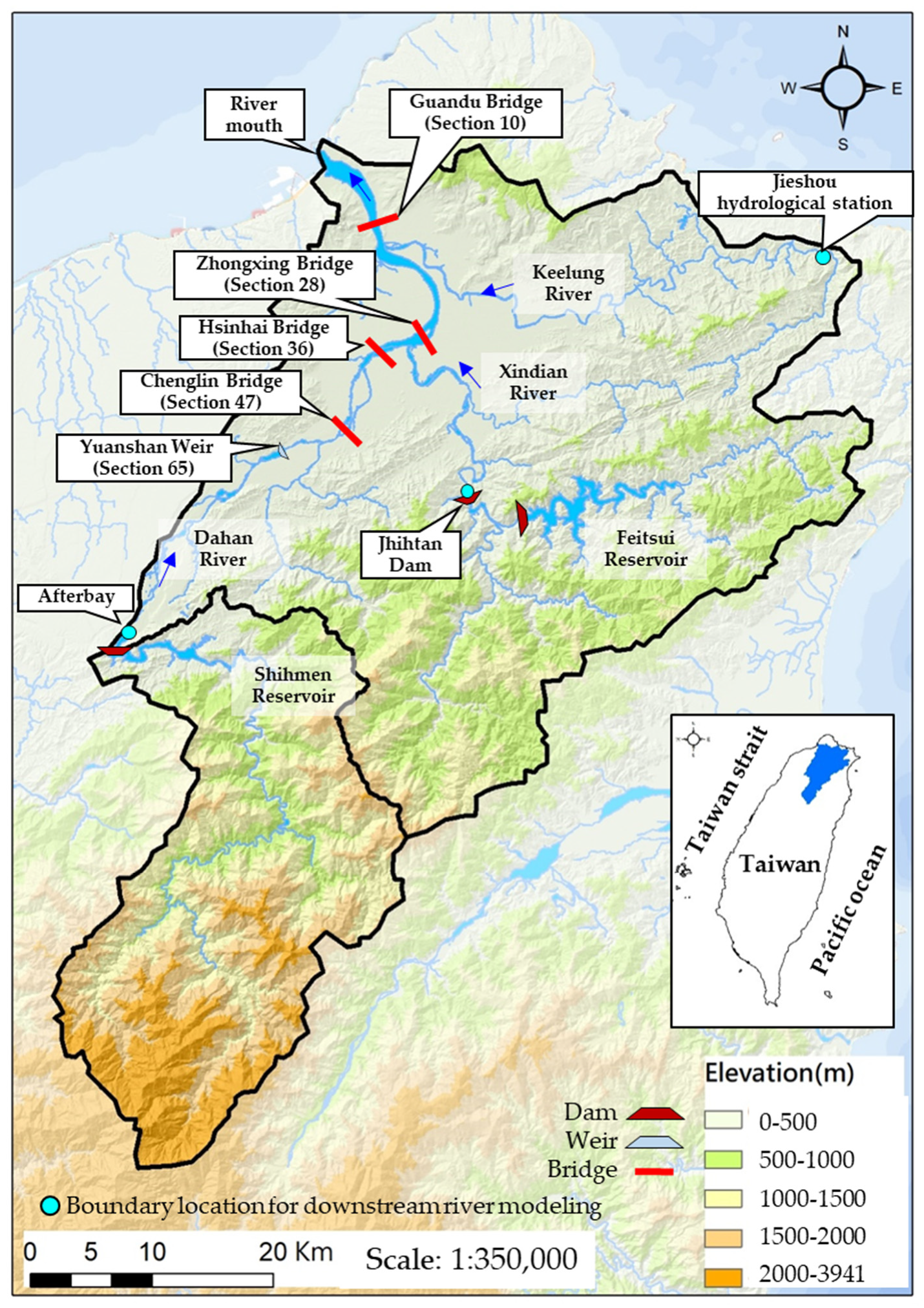
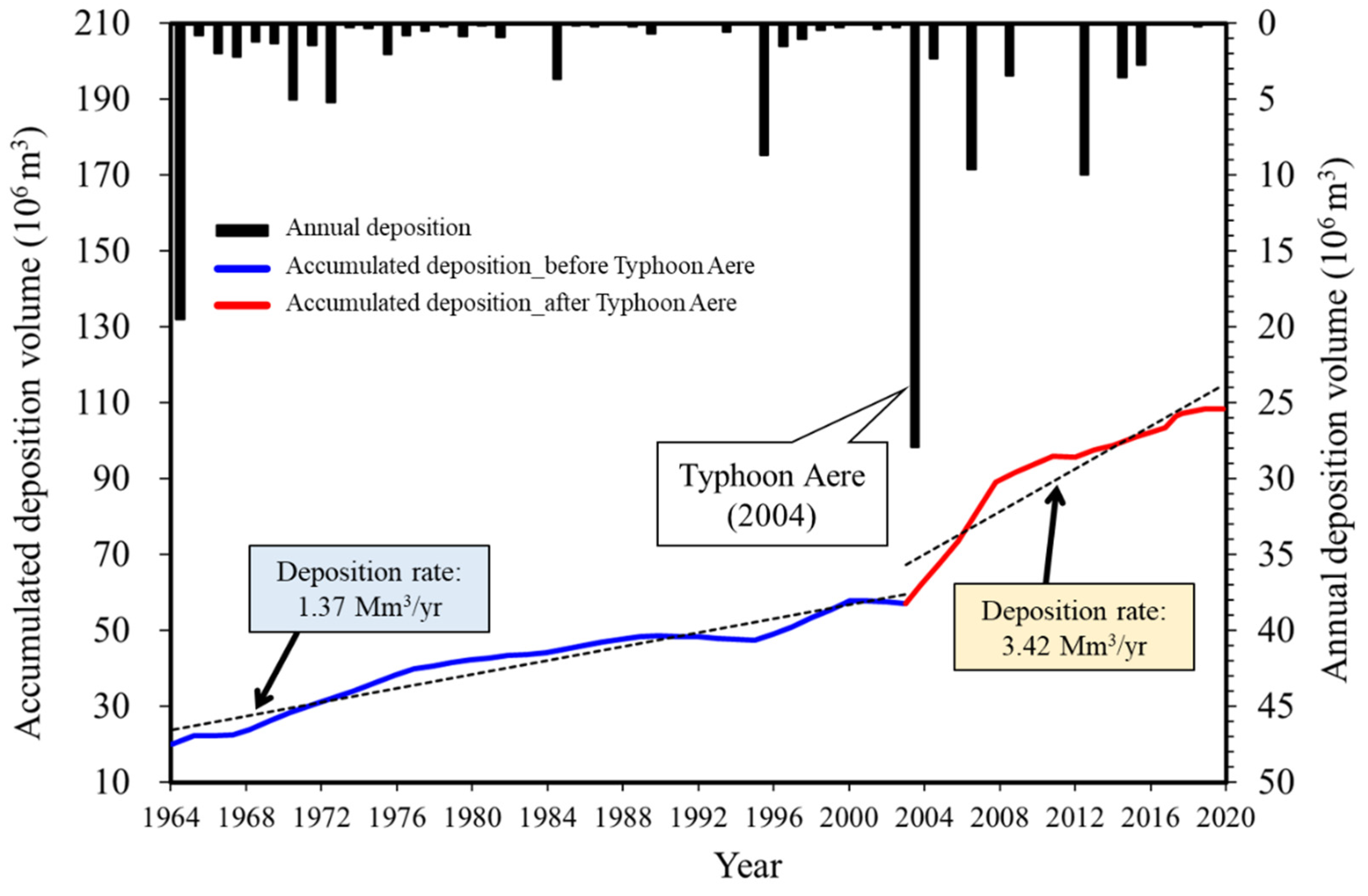
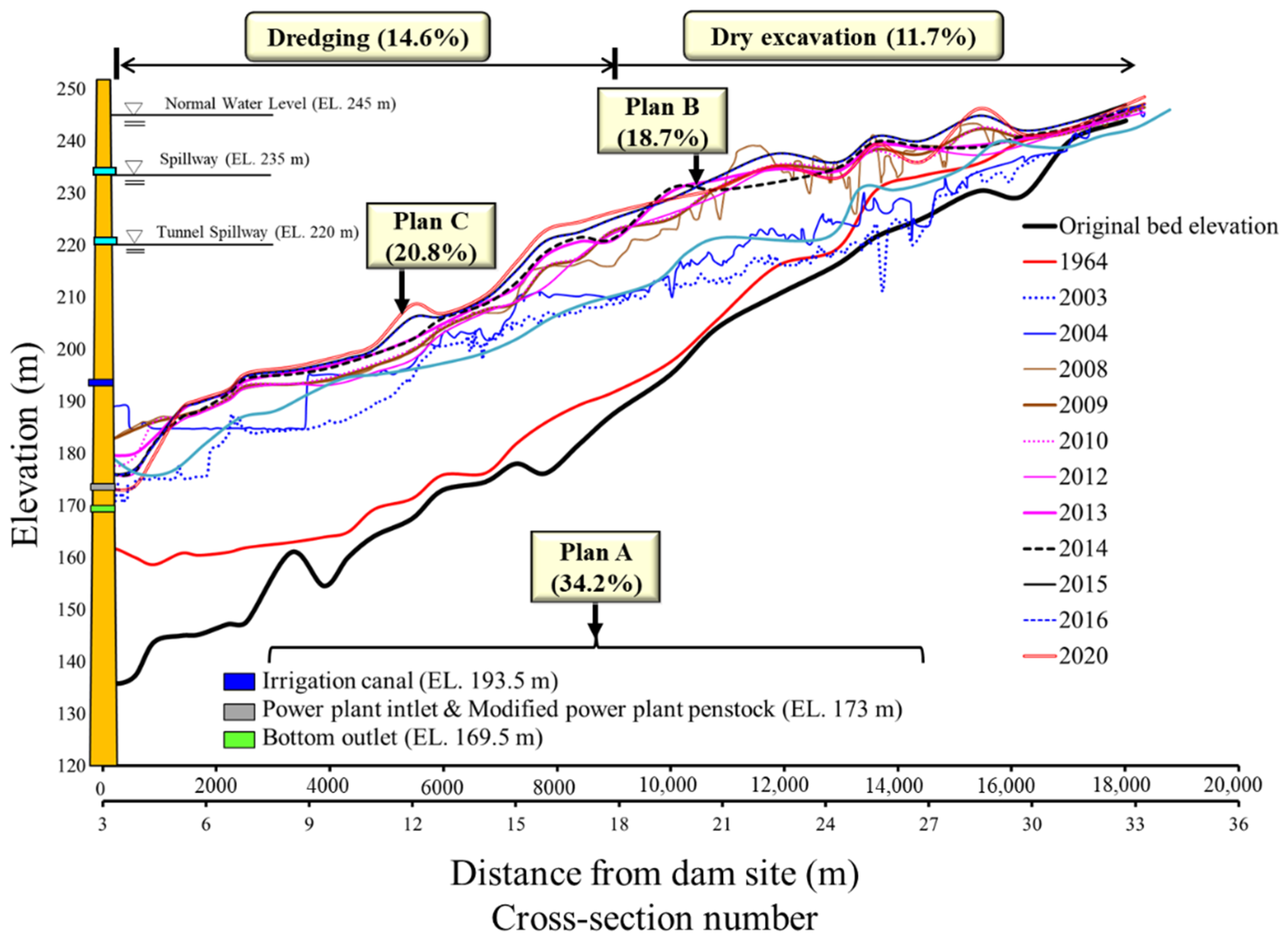
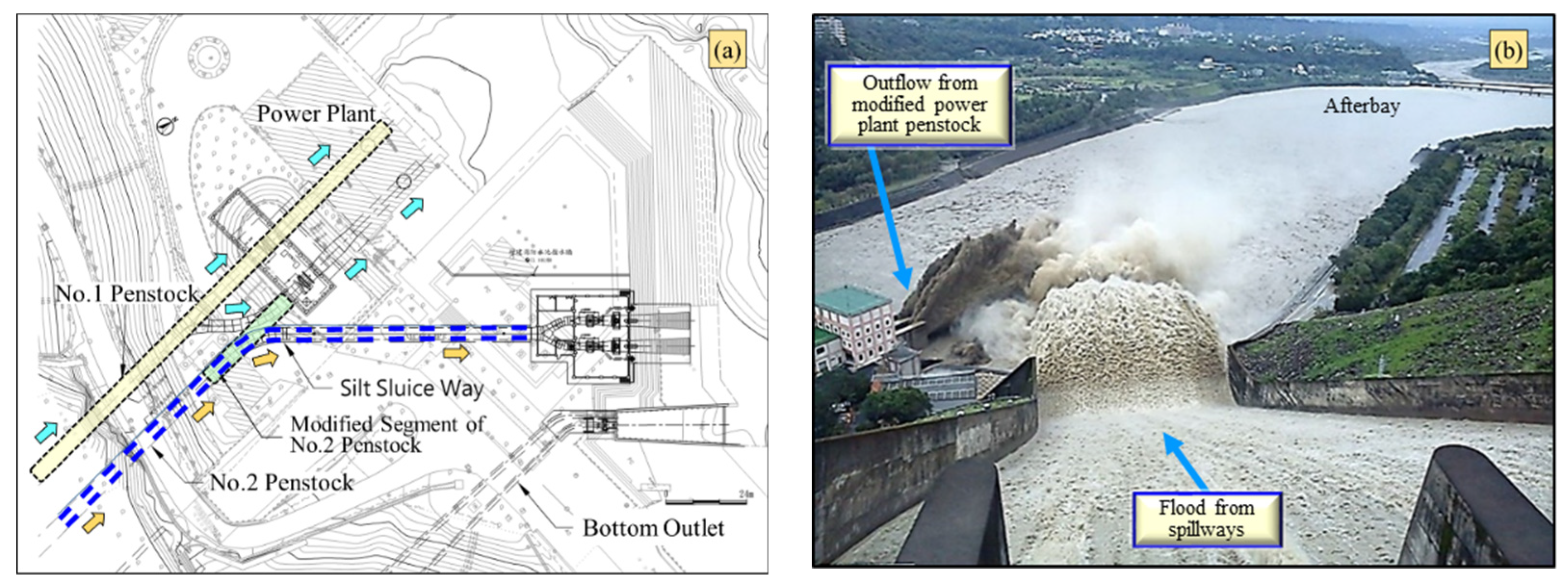

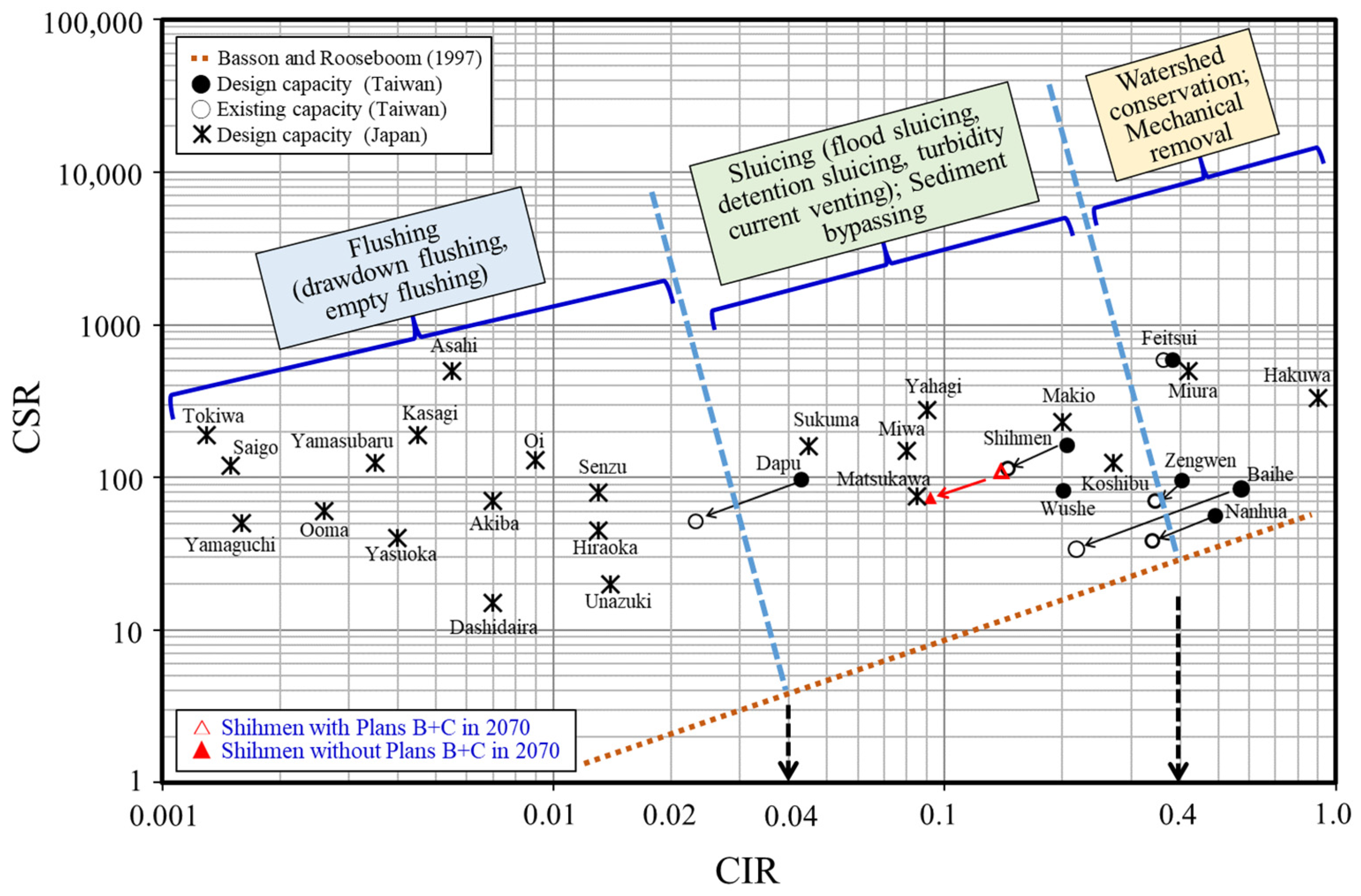

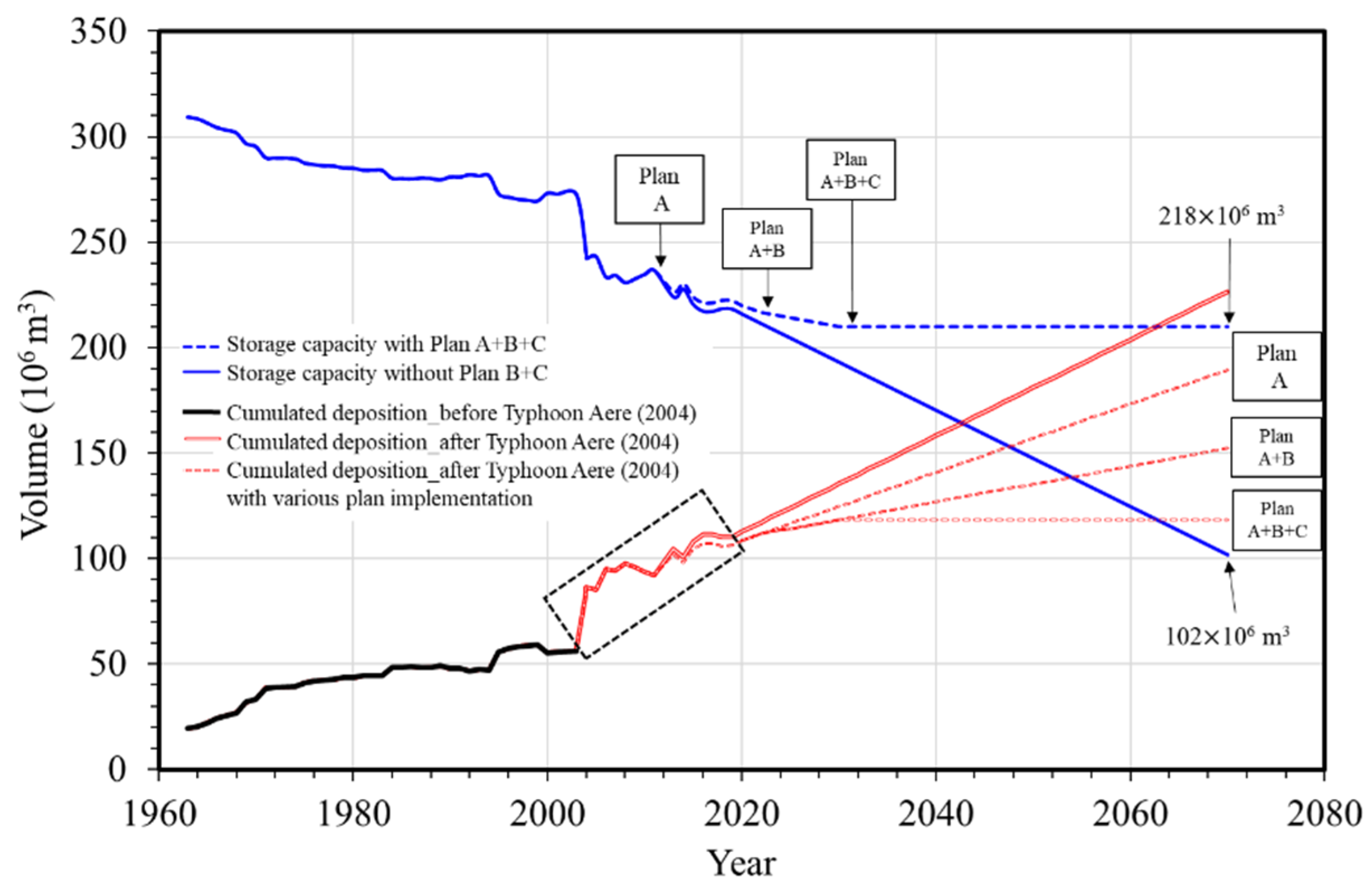
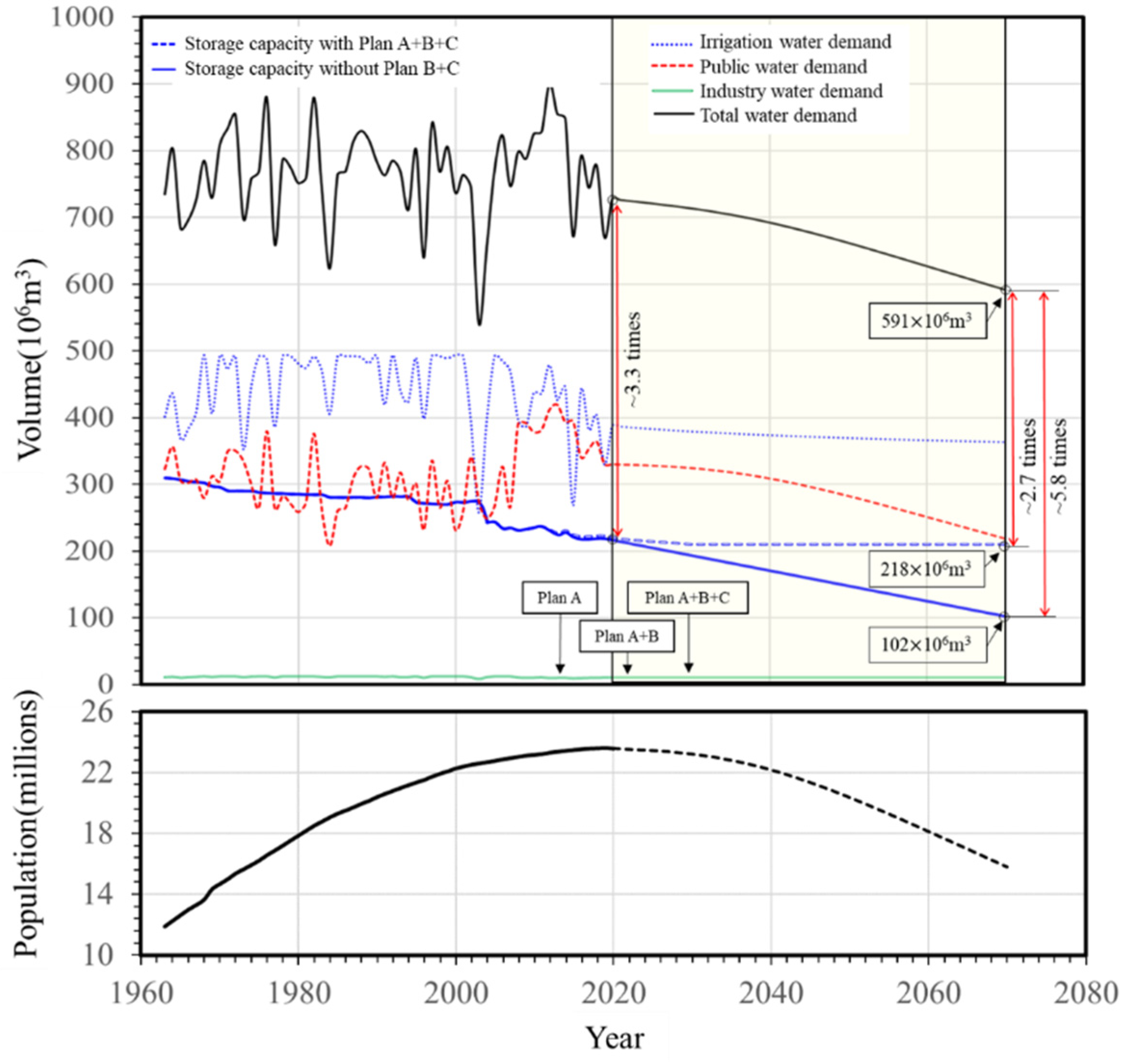

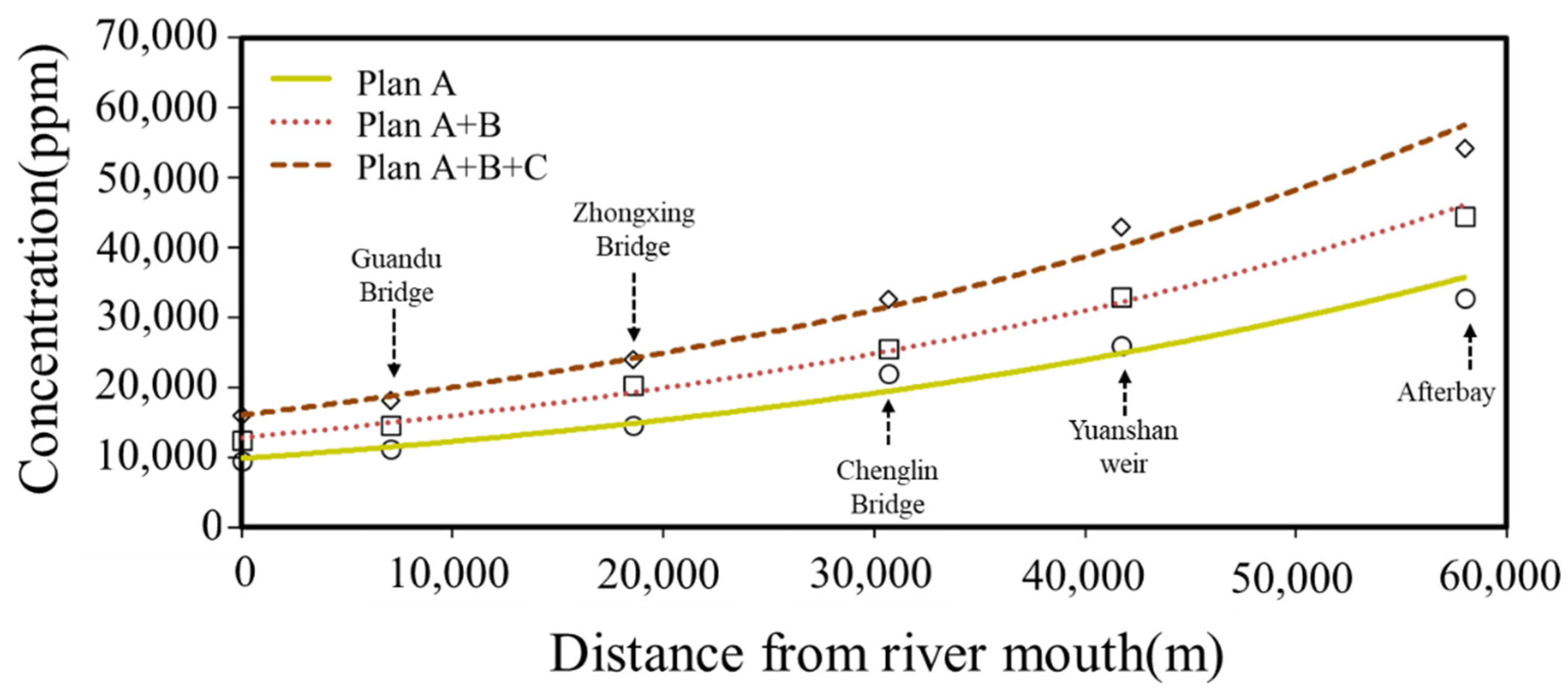
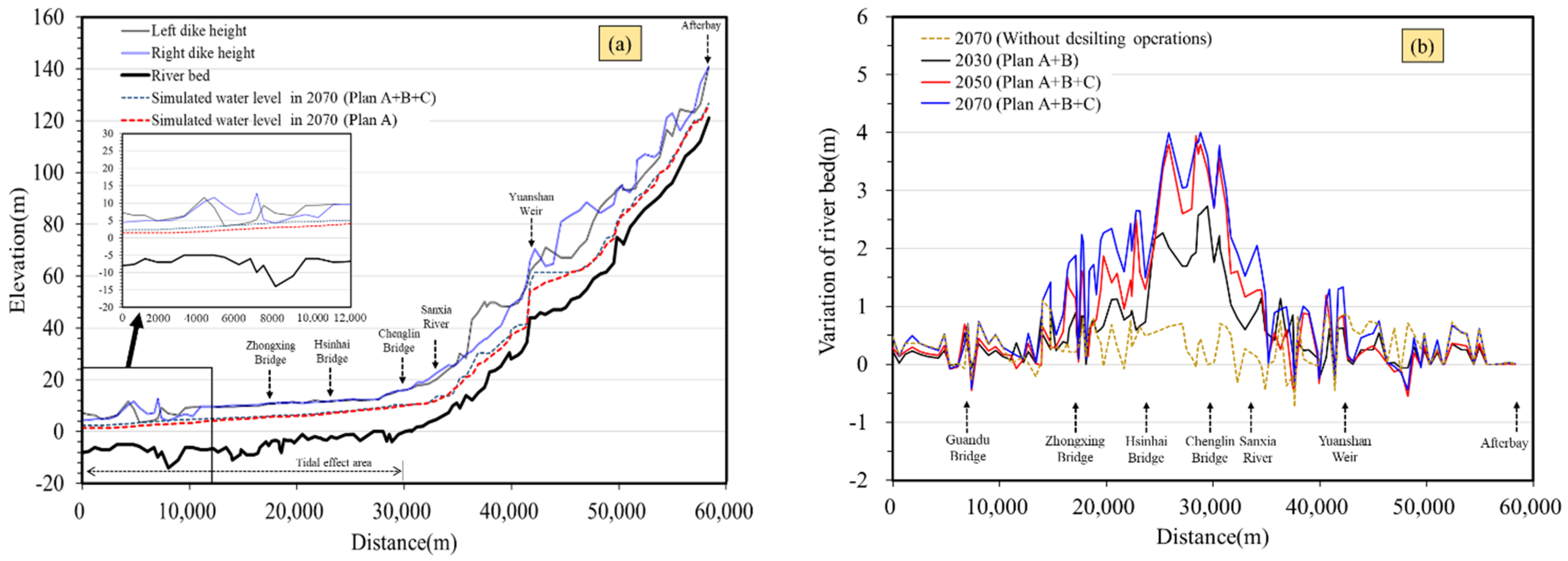
| Typhoon Event | Date (dd/mm/yy) | Peak Discharge (m3/s) | Inflow Discharge Volume (106 m3) | Inflow Sediment Volume (106 m3) | Deposited Sediment Volume (106 m3) | Total Desilting Efficiency (%) | Desilting Efficiency at Modified Power Plant Penstock (%) |
|---|---|---|---|---|---|---|---|
| Aere | 23 August 2004 | 8594 | 713.87 | -- | 27.88 | -- | -- |
| Fungwong | 26 July 2008 | 2040 | 124.47 | 2.33 | 2.03 | 12.70 | -- |
| Sinlaku | 11 September 2008 | 3447 | 633.44 | 13.12 | 9.65 | 27.00 | -- |
| Jangmi | 26 September 2008 | 3292 | 230.50 | 5.25 | 4.30 | 17.50 | -- |
| Morakot | 5 August 2009 | 1838 | 227.99 | 2.39 | 2.05 | 13.60 | -- |
| Saola | 30 July 2012 | 5385 | 492.30 | 9.95 | 8.45 | 15.10 | -- |
| Soulik | 11 July 2013 | 5458 | 264.10 | 11.98 | 7.79 | 35.00 | 6.65 |
| Trami | 20 August 2013 | 2412 | 165.31 | 4.17 | 2.62 | 37.20 | 14.26 |
| Soudelor | 6 August 2015 | 5634 | 296.39 | 3.30 | 2.13 | 35.60 | 7.16 |
| Dujuan | 27 September 2015 | 3802 | 195.19 | 2.45 | 1.65 | 32.60 | 8.08 |
| Megi | 25 September 2016 | 4268 | 294.85 | 4.56 | 3.61 | 20.90 | 5.73 |
Publisher’s Note: MDPI stays neutral with regard to jurisdictional claims in published maps and institutional affiliations. |
© 2022 by the authors. Licensee MDPI, Basel, Switzerland. This article is an open access article distributed under the terms and conditions of the Creative Commons Attribution (CC BY) license (https://creativecommons.org/licenses/by/4.0/).
Share and Cite
Lee, F.-Z.; Lai, J.-S.; Sumi, T. Reservoir Sediment Management and Downstream River Impacts for Sustainable Water Resources—Case Study of Shihmen Reservoir. Water 2022, 14, 479. https://doi.org/10.3390/w14030479
Lee F-Z, Lai J-S, Sumi T. Reservoir Sediment Management and Downstream River Impacts for Sustainable Water Resources—Case Study of Shihmen Reservoir. Water. 2022; 14(3):479. https://doi.org/10.3390/w14030479
Chicago/Turabian StyleLee, Fong-Zuo, Jihn-Sung Lai, and Tetsuya Sumi. 2022. "Reservoir Sediment Management and Downstream River Impacts for Sustainable Water Resources—Case Study of Shihmen Reservoir" Water 14, no. 3: 479. https://doi.org/10.3390/w14030479
APA StyleLee, F.-Z., Lai, J.-S., & Sumi, T. (2022). Reservoir Sediment Management and Downstream River Impacts for Sustainable Water Resources—Case Study of Shihmen Reservoir. Water, 14(3), 479. https://doi.org/10.3390/w14030479








